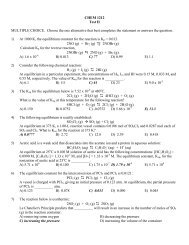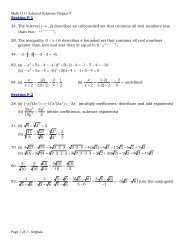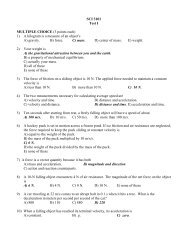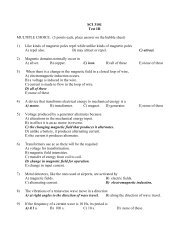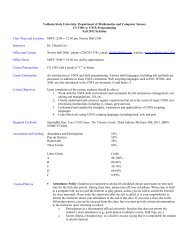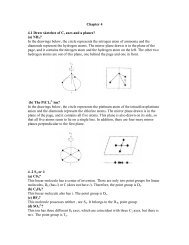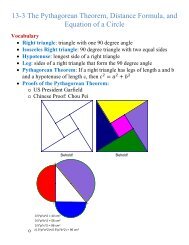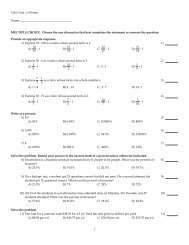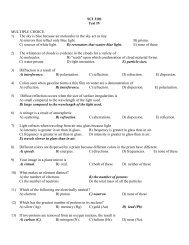Unit 3 Practice Exam
Unit 3 Practice Exam
Unit 3 Practice Exam
Create successful ePaper yourself
Turn your PDF publications into a flip-book with our unique Google optimized e-Paper software.
<strong>Unit</strong> #3 <strong>Practice</strong> <strong>Exam</strong><br />
Name___________________________________<br />
MULTIPLE CHOICE. Choose the one alternative that best completes the statement or answers the question.<br />
Determine whether the number is abundant or deficient.<br />
1) 8<br />
A) Deficient B) Abundant<br />
1)<br />
2) 34<br />
A) Abundant B) Deficient<br />
2)<br />
Find the mixed number or rational fraction in simplest terms represented by the repeating decimal.<br />
3) 0.1<br />
A) 1 9<br />
B)<br />
10<br />
999<br />
C)<br />
1<br />
99<br />
D) 10<br />
99<br />
3)<br />
4) 0.814<br />
A) 74<br />
9<br />
B) 220<br />
27<br />
C) 740<br />
9<br />
D) 22<br />
27<br />
4)<br />
Use the least common multiple or greatest common factor to solve the problem.<br />
5) Mark has 153 hot dogs and 261 hot dog buns. He wants to put the same number of hot dogs and<br />
hot dog buns on each tray. What is the greatest number of trays Mark can use to accomplish<br />
this<br />
A) 9 B) 3 C) 493 D) 51<br />
5)<br />
6) Planets A, B, and C orbit a certain star once every 3, 7, and 18 months, respectively. If the three<br />
planets are now in the same straight line, what is the smallest number of months that must<br />
pass before they line up again<br />
A) 28 months B) 378 months C) 126 months D) 54 months<br />
6)<br />
7) A brick layer is hired to build three walls of equal length. He has bricks which are 9 inches, 27<br />
inches, and 21 inches long. He plans to build one wall out of each type of brick. What is the<br />
shortest length of wall possible<br />
A) 189 inches B) 5103 inches C) 567 inches D) 57 inches<br />
7)<br />
Write the fraction that represents the shaded area.<br />
8)<br />
8)<br />
A) 3 4<br />
B) 7 8<br />
C) 7 4<br />
D) 1 7<br />
1
9)<br />
9)<br />
A) 1 5<br />
B) 5 1<br />
C) 5 6<br />
D) 5 3<br />
Decide whether or not the first number is divisible by the second.<br />
10) 186,096; 4<br />
A) No B) Yes<br />
10)<br />
11) 527,417; 9<br />
A) Yes B) No<br />
11)<br />
12) 848,394; 3<br />
A) No B) Yes<br />
12)<br />
Provide the appropriate response.<br />
13) What is the greatest prime number you must consider to test whether 5141 is prime<br />
A) 101 B) 97 C) 47 D) 71<br />
13)<br />
14) Find the least positive number divisible by two primes.<br />
A) 2 B) 4 C) 6 D) 3<br />
14)<br />
Find the GCF of the numbers using an appropriate method.<br />
15) 144 and 216<br />
A) 432 B) 6 C) 72 D) 24<br />
15)<br />
16) 44 and 567<br />
A) 22 B) 77 C) 1 D) 6<br />
16)<br />
Find the requested fraction.<br />
17) An equivalent fraction to the fraction 4 11<br />
would be:<br />
17)<br />
A) 35<br />
84<br />
B) 32<br />
99<br />
C) 24<br />
72<br />
D) 28<br />
77<br />
18) An equivalent fraction to the fraction - 6<br />
would be:<br />
54<br />
18)<br />
A) - 7<br />
72<br />
B) - 12<br />
60<br />
C) - 5<br />
45<br />
D) - 1<br />
10<br />
2
Write the decimal in the form indicated.<br />
19) 9.003812; expanded exponential form<br />
A) 9 · 100 + 0 · 10-1 + 0 · 10-2 + 3 · 10-3<br />
+ 8 · 10-4 + 1 · 10-5 + 2 · 10-6<br />
C) 9 · 100 + 0 · 101 + 0 · 102 + 3 · 103<br />
+ 8 · 104 + 1 · 105 + 2 · 106<br />
B) 9 · 100 + 3 · 10-1 + 8 · 10-2 + 1 · 10-3<br />
+ 2 · 10-4<br />
D) 9 · 101 + 0 · 100 + 0 · 10-1 + 3 · 10-2<br />
+ 8 · 10-3 + 1 · 10-4 + 2 · 10-5<br />
19)<br />
Write the number in scientific notation.<br />
20) 0.000209<br />
A) 2.09 × 10 - 4 B) 2.09 × 10 - 3 C) 2.09 × 10 - 5 D) 2.09 × 104<br />
21) 5,961,000,000<br />
A) 5.961 × 109 B) 5.961 × 106 C) 5961 × 10 - 6 D) 596.1 × 107<br />
20)<br />
21)<br />
Use the figures to answer the question.<br />
22) What fraction of figure 4 is shaded<br />
A) 1 3<br />
B) 2 5<br />
C)<br />
2<br />
10<br />
D) 4 5<br />
22)<br />
23) What fraction of figure 9 is shaded<br />
23)<br />
A) 1 2<br />
B) 1 3<br />
C) 2 3<br />
D) 1 4<br />
24) Name the figure which is a fraction strip depicting 3 10 .<br />
24)<br />
A) Figure 5 B) Figure 10<br />
C) Figure 11 D) None of the above<br />
Decide whether or not the first number is divisible by the second.<br />
25) 23,256; 6<br />
A) Yes B) No<br />
25)<br />
3
26) 384,944; 7<br />
A) Yes B) No<br />
26)<br />
27) 22,219; 2<br />
A) Yes B) No<br />
27)<br />
28) 81,404,159; 11<br />
A) No B) Yes<br />
28)<br />
Write the numbers in order of increasing size.<br />
29) 0.5866, 0.586, 0.58666, 0.586<br />
A) 0.586, 0.58666, 0.5866, 0.586 B) 0.586, 0.5866, 0.58666, 0.586<br />
C) 0.586, 0.586, 0.5866, 0.58666 D) 0.586, 0.586, 0.5866, 0.58666<br />
29)<br />
30) 2.25, 2 5 8 , 2.52, 2 4 9<br />
30)<br />
A) 2 5 8 , 2.52, 2 4 9 , 2.25 B) 2 4 9 , 2 5 , 2.25, 2.52<br />
8<br />
C) 2.25, 2.52, 2 4 9 , 2 5 8<br />
D) 2.25, 2 4 9 , 2.52, 2 5 8<br />
Find all the factors of the number.<br />
31) 45<br />
A) 1, 2, 3, 5, 9, 15, 30, 45 B) 1, 3, 5, 9, 15, 45<br />
C) 1, 3, 5, 9, 15, 30, 45 D) 1, 3, 5, 15, 45<br />
31)<br />
Convert to standard notation.<br />
32) 4.296 × 10-5<br />
A) -429,600 B) 0.0004296 C) 0.000004296 D) 0.00004296<br />
32)<br />
33) 7.53 × 103<br />
A) 75,300 B) 7530 C) 225.9 D) 753<br />
33)<br />
Find the prime factorization of the number, and write it in exponent form.<br />
34) 25,760,268<br />
A) 22 × 34 × 433 B) 26 × 3483 C) 2 × 3 × 79,507 D) 38 × 1849<br />
34)<br />
Arrange the fractions in ascending order. Or, if the fractions are equivalent, answer "Equivalent".<br />
35) 3 4 , 10<br />
13 , 8 11<br />
A)<br />
8<br />
11 , 3 4 , 10<br />
13<br />
B) 3 4 , 8 11 , 10<br />
13<br />
C) 10<br />
13 , 8 11 , 3 4<br />
35)<br />
36) 4 15 , 5 16<br />
36)<br />
A)<br />
4<br />
15 , 5 16<br />
B)<br />
5<br />
16 , 4 15<br />
C) Equivalent<br />
4
Solve the problem.<br />
37) For lunch, Jamie bought a 8-inch submarine sandwich. What fraction of a foot was Jamie's 37)<br />
sandwich (1 foot = 12 inches)<br />
7<br />
A)<br />
12 ft B) 2 3 ft C) 5 6 ft D) 5<br />
12 ft<br />
38) Julia preheated her oven for 19 minutes. What fraction of an hour was this (1 hour = 60 min) 38)<br />
7<br />
A)<br />
20 hr B) 2 19<br />
hr C)<br />
5 60 hr D) 3<br />
10 hr<br />
Write the fraction as a terminating decimal.<br />
39) 29<br />
40<br />
A) 0.685 B) 0.725 C) 0.625 D) 0.735<br />
39)<br />
Determine whether the statement is true or false.<br />
40) If a natural number is divisible by 5 and 2, then it must also be divisible by 10.<br />
A) True B) False<br />
40)<br />
41) Zero is a multiple of every number.<br />
A) True B) False<br />
41)<br />
42) If n is a natural number and 4 | n, then 8 | n.<br />
A) True B) False<br />
42)<br />
Find the least common multiple for the numbers.<br />
43) 27, 63<br />
A) 63 B) 21 C) 1701 D) 189<br />
43)<br />
Identify the number as either prime or composite.<br />
44) 113<br />
A) Composite B) Prime<br />
44)<br />
45) 66<br />
A) Composite B) Prime<br />
45)<br />
Find the LCM for the given numbers by an appropriate method.<br />
46) 24, 54, and 27<br />
A) 54 B) 72 C) 216 D) 108<br />
46)<br />
Write the decimal as a fraction in simplest terms.<br />
47) 0.844<br />
1<br />
A)<br />
B) 211<br />
844<br />
500<br />
C) 211<br />
250<br />
D) 211<br />
125<br />
47)<br />
Find all values of the missing digit that make the statement true.<br />
48) 4,3_1 is divisible by 3.<br />
A) 3, 6, 9 B) 4, 6, 7, 8 C) 1, 4, 7 D) 1, 4, 7, 8<br />
48)<br />
5
49) 214,21_ is divisible by 11.<br />
A) 4 B) 3 C) 6 D) 2<br />
49)<br />
Find the GCF of the numbers.<br />
50) 120, 1000, 2250<br />
A) 50 B) 30 C) 20 D) 10<br />
50)<br />
6
Answer Key<br />
Testname: UNIT-3-PRACTICE-EXAM<br />
1) A<br />
Objective: (4.1) Determine Whether Number is<br />
Abundant or Deficient<br />
2) B<br />
Objective: (4.1) Determine Whether Number is<br />
Abundant or Deficient<br />
3) A<br />
Objective: (6.5) Convert Repeating Decimal to Fraction<br />
4) D<br />
Objective: (6.5) Convert Repeating Decimal to Fraction<br />
5) A<br />
Objective: (4.2) Solve Apps: GCF and LCM<br />
6) C<br />
Objective: (4.2) Solve Apps: GCF and LCM<br />
7) A<br />
Objective: (4.2) Solve Apps: GCF and LCM<br />
8) C<br />
Objective: (6.1) Recognize Fraction from Model<br />
9) D<br />
Objective: (6.1) Recognize Fraction from Model<br />
10) B<br />
Objective: (4.1) Determine Divisibility II (Y/N)<br />
11) B<br />
Objective: (4.1) Determine Divisibility II (Y/N)<br />
12) B<br />
Objective: (4.1) Determine Divisibility II (Y/N)<br />
13) D<br />
Objective: (4.2) Know Concepts: Prime Numbers and<br />
Divisibility<br />
14) C<br />
Objective: (4.2) Know Concepts: Prime Numbers and<br />
Divisibility<br />
15) C<br />
Objective: (4.2) Find GCF by Appropriate Method<br />
16) C<br />
Objective: (4.2) Find GCF by Appropriate Method<br />
17) D<br />
Objective: (6.1) Identify Equivalent Fractions<br />
18) C<br />
Objective: (6.1) Identify Equivalent Fractions<br />
19) A<br />
Objective: (6.1) Use Decimal and Expanded Notation<br />
20) A<br />
Objective: (6.1) Write Number in Scientific Notation<br />
21) A<br />
Objective: (6.1) Write Number in Scientific Notation<br />
22) B<br />
Objective: (6.1) Use Model to Depict Formula<br />
7<br />
23) C<br />
Objective: (6.1) Use Model to Depict Formula<br />
24) D<br />
Objective: (6.1) Use Model to Depict Formula<br />
25) A<br />
Objective: (4.1) Determine Divisibility I (Y/N)<br />
26) A<br />
Objective: (4.1) Determine Divisibility I (Y/N)<br />
27) B<br />
Objective: (4.1) Determine Divisibility I (Y/N)<br />
28) A<br />
Objective: (4.1) Determine Divisibility I (Y/N)<br />
29) B<br />
Objective: (6.5) Order Decimals and Fractions<br />
30) D<br />
Objective: (6.5) Order Decimals and Fractions<br />
31) B<br />
Objective: (4.1) List All Factors of a Number<br />
32) D<br />
Objective: (6.5) Convert Scientific Notation to Standard<br />
Notation<br />
33) B<br />
Objective: (6.5) Convert Scientific Notation to Standard<br />
Notation<br />
34) A<br />
Objective: (4.2) Find Prime Factorization of Number<br />
35) A<br />
Objective: (6.5) Order Rational Numbers<br />
36) A<br />
Objective: (6.5) Order Rational Numbers<br />
37) B<br />
Objective: (6.1) Solve Apps: Rational Numbers<br />
38) C<br />
Objective: (6.1) Solve Apps: Rational Numbers<br />
39) B<br />
Objective: (6.1) Convert Fraction to Terminating<br />
Decimal<br />
40) A<br />
Objective: (4.1) Know Concepts: Factors and Divisibility<br />
41) A<br />
Objective: (4.1) Know Concepts: Factors and Divisibility<br />
42) B<br />
Objective: (4.1) Know Concepts: Factors and Divisibility<br />
43) D<br />
Objective: (4.2) Find LCM by Intersection of Sets<br />
Method
Answer Key<br />
Testname: UNIT-3-PRACTICE-EXAM<br />
44) B<br />
Objective: (4.2) Identify Number as Prime or<br />
Composite<br />
45) A<br />
Objective: (4.2) Identify Number as Prime or<br />
Composite<br />
46) C<br />
Objective: (4.2) Find LCM by Appropriate Method<br />
47) C<br />
Objective: (6.1) Convert Decimal to Fraction<br />
48) C<br />
Objective: (4.1) Determine Missing Digit for Divisibility<br />
49) A<br />
Objective: (4.1) Determine Missing Digit for Divisibility<br />
50) D<br />
Objective: (4.2) Find GCF by Intersection of Sets<br />
Method<br />
8






